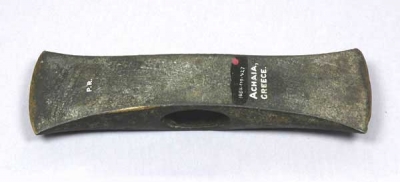155
353
362
384
376
173
166
321
169
153
175
164
162
320
151
180
330
161
326
149
361
363
379
377
152
150
176
182
365
230
369
371
174
374
357
154
340
327
179
158
347
337
160
227
342
159
356
183
359
360
339
324
178
170
171
334
335
167
181
148
380
157
177
168
349
172
316
319
163
378
381
370
156
Mycaenean axe head (1884.119.427)
 GreeceMycaenean axe head from Greece, Europe. Part of the Pitt Rivers Museum Founding Collection. Given to the Museum in 1884.
GreeceMycaenean axe head from Greece, Europe. Part of the Pitt Rivers Museum Founding Collection. Given to the Museum in 1884.
This eye-hafted, double-ended axe-head or 'labrys' is said to come from Achaea, a prefecture (administrative region) of Greece situated on the northern coast of the Peloponnese. Bronze weapons such as this were often offered as votive gifts to war goddesses or deposited in graves of high-status individuals. This example probably dates to the early Mycenaean period (c.1600-1400 BC), during the later stages of the Bronze Age in Greece. The labrys is an important symbol of European prehistory but by 1200 BC it has been superseded by the central European single-bladed form of axe.





